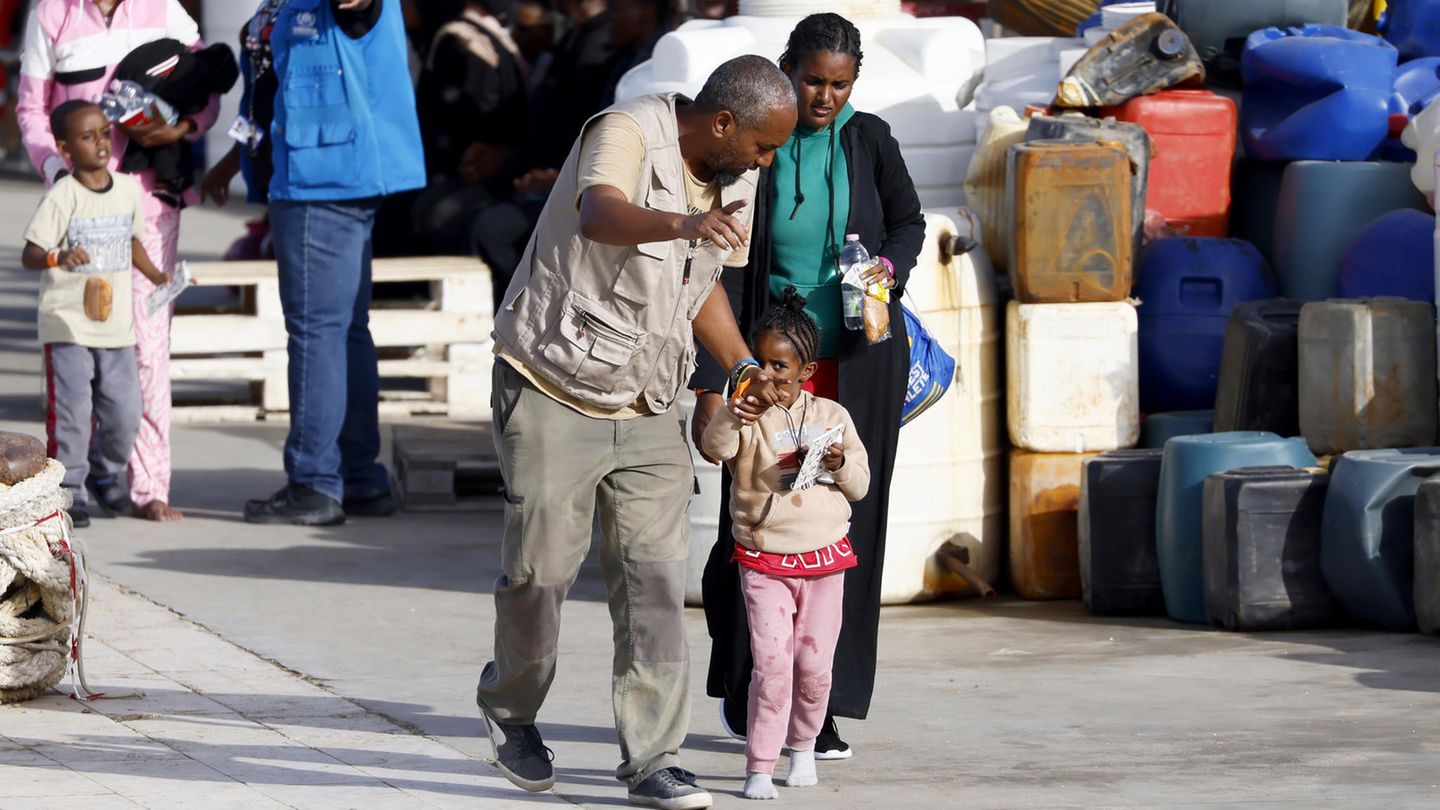The debate about asylum policy is heating up, and after months of hesitation, Germany has now cleared the way for European asylum reform. How many refugees actually live in Germany and the EU? And how many are currently joining?
Despite ongoing concerns, Germany wants to agree to the controversial crisis regulation as part of the planned EU asylum reform. “Although we still need to make further changes and beyond, we are living up to our responsibility today,” said Federal Interior Minister Nancy Faeser (SPD) on Thursday in Brussels at the EU Interior Ministers’ meeting. That’s why we will agree to the compromise.
The crisis regulation is a central element of the planned EU asylum reform, which is intended, among other things, to limit unwanted migration. For example, if there is a particularly strong increase in migration, the period during which people can be held in prison-like conditions should be extended. In addition, the circle of people who are eligible for the planned strict border procedures could be increased.
The Greens in the traffic light coalition had blocked German approval for a long time because they feared that asylum standards would be undermined. Chancellor Olaf Scholz (SPD) then apparently gave his approval.
In Germany and Europe, with the higher number of refugees, the debate about asylum and migration is also gaining momentum. For example, upper limits and stricter border controls are being discussed again. A look at numbers and facts.
How many refugees are currently coming to the EU?
In the first half of 2023, the number of asylum applications in the European Union climbed to 519,000, an increase of 28 percent compared to the same period last year. In addition, according to the EU Asylum Agency, around four million war refugees from Ukraine who do not have to apply for asylum due to a special rule are currently enjoying temporary protection; most of them came in 2022.
In 2022 as a whole, around 966,000 people applied for asylum in the EU, the highest figure since 2016. To put this into perspective, it is just as important: According to the EU Commission, the proportion of refugees in the total population was 1.5 percent in 2022.
Is Germany the EU country with the most asylum applications?
Yes. According to data from the European Asylum Agency, by far the most asylum applications were made in Germany in the first half of the year: 30 percent of all applications – and therefore almost twice as many as in the next countries Spain (17 percent) and France (16 percent). Behind them was Austria, then Italy.
When compared to the population, however, things look different: While there were 29 applications per 10,000 inhabitants in the Federal Republic in 2022, the ratio was in some cases far higher in eight EU states: for example in Cyprus (241) and Austria (123).
How many people seeking protection live in Germany?
According to the Federal Statistical Office, there were around 3.1 million people seeking protection living in Germany at the end of 2022, with the majority (2.25 million) having recognized protection status.
The total number increased by 1.14 million people compared to the previous year, which represents the highest increase within a reporting year since statistics began in 2007. This is primarily due to the Russian war of aggression, which is why around 1.01 million Ukrainians sought protection in Germany in 2022.
Migration 2023
Most refugees come to Germany from these countries
Where do those seeking protection come from?
In addition to Ukrainians, most of those seeking protection at the end of 2022 were Syrian (674,000 people), Afghan (286,000), Iraqi (211,000) or Turkish (101,000) nationals. These five nationalities make up almost three quarters of those seeking protection. The Federal Statistical Office includes all foreigners who are staying in Germany citing humanitarian reasons. This also includes asylum seekers in the process and rejected asylum seekers.
How many people are currently coming to Germany?
Recently the number of new arrivals has increased. According to the Federal Office for Migration and Refugees (Bamf), 220,116 people applied for asylum in this country between January and August 2023, most of them from Syria and Afghanistan. In around nine out of ten cases (204,461) these were initial applications after a new arrival or birth.
How does this fit into long-term development?
Compared to the same period last year (January to August), the number of asylum applications in 2023 increased by more than 77 percent. In 2015 and 2016, when many refugees came to Germany, the figures for the year as a whole were 476,649 and 745,545 applications.
What about war refugees from Ukraine?
They do not have to apply for asylum and are therefore not included in the asylum statistics. People who have fled from Eastern European non-EU countries must also be accommodated and cared for in Germany. Since the Russian attack on the country in February 2022, their numbers have skyrocketed. According to Eurostat, there will be 1.15 million war refugees from Ukraine in this country at the end of July 2023.
How many refugees are actually allowed to stay?
Between January and August 2023, the Bamf decided on a good 175,000 asylum applications. More than 91,000 people were granted protection, which corresponds to an overall protection rate of around 52 percent.
However, the adjusted protection rate is more meaningful. Because many applications are decided without examining the content. This is the case, for example, if an asylum application has been withdrawn or another EU country is responsible. If you subtract the “formal decisions” from the cases processed, you get an adjusted protection rate of 71 percent for the period between January and August.
How will the people who have arrived be distributed?
Anyone who comes to Germany as a refugee must first register. This usually happens in the nearest initial reception center in the respective federal state. Distribution among the states is based on the “Königstein Key”. According to this, the most populous federal state of North Rhine-Westphalia should take in the most people seeking protection at 21 percent, followed by Bavaria (15.6 percent) and Baden-Württemberg (around 13 percent).
Based on the population of the federal states, at the end of 2022, according to the Federal Statistical Office, most of those seeking protection lived in the city states of Bremen (6.3 percent of the population), Hamburg (4.8) and Berlin (4.8). The proportions were lowest in Bavaria (2.8), Brandenburg (2.8) and Mecklenburg-Western Pomerania (2.9).
How many have to leave Germany?
If the asylum decision is negative, there is a risk of deportation. According to the Central Register of Foreigners, a total of 304,308 people in Germany were required to leave the country at the end of 2022, of which 248,145 had a toleration permit. In addition to rejected asylum seekers, tourists, employees and foreign students may also be required to leave the country if their visa or residence permit has expired.
Tolerated persons cannot be deported for certain reasons, for example because they do not have identification documents, are sick or have a minor child who has a residence permit. Toleration is always limited.
According to the federal government, almost 13,000 people who were required to leave the country were deported from Germany in 2022.
Appeals can also be lodged against Bamf decisions. In 2022, courts decided in 96,495 cases. Subsequently, asylum decisions were made positively (461 times), refugee protection (5,396) or subsidiary protection was granted (1,353) and a ban on deportation was issued (9,385).
What is asylum and who can apply for it?
In Germany, the right to asylum is anchored in the Basic Law: “Those who are politically persecuted enjoy the right to asylum,” says Article 16a. It is the only fundamental right that only foreigners are entitled to. In fact, most people receive protection under the Geneva Refugee Convention or limited (subsidiary) protection. This applies to people who are threatened with torture, the death penalty or arbitrary violence in an armed conflict at home.
When is there no chance of asylum?
The exclusion criteria for a right to protection are crimes and serious criminal offenses, or if the person poses a threat to the security of Germany. There is usually no right to asylum if the foreigner comes from one of the so-called safe countries of origin – such as the EU, Western Balkan states, Ghana and Senegal. Even if protection already exists from a safe third country (EU, Norway, Switzerland), it will no longer be possible to apply for asylum in Germany.
What benefits do they receive and when are they allowed to work?
Whether those seeking protection are allowed to work and receive social benefits depends on their respective status. Those entitled to asylum, i.e. recognized refugees or those entitled to subsidiary protection, are generally allowed to work. You are therefore entitled to citizen’s benefit of currently 502 euros (single people). Asylum seekers and tolerated persons generally require a work permit from the immigration authorities. The Federal Employment Agency (BA) usually has to approve employment.
An asylum procedure can take a long time – that’s how long other social benefits are available. These are regulated in the Asylum Seekers Benefits Act. Single people receive a total of 410 euros per month.
What about Ukrainians who fled?
Ukrainians who fled because of the Russian war of aggression are exempt from this legal regulation for asylum seekers. As recognized war refugees, they are treated on an equal footing with German citizens in terms of social benefits from day one and can apply for citizen’s benefit.
Ukrainians also live in other EU countries – what is the situation there?
Not only Germany supplies hundreds of thousands of Ukrainians, but also closer neighbors of the attacked state. At the end of July 2023, there were over 970,000 non-EU citizens from Ukraine registered in Poland, and almost 370,000 in the Czech Republic. If you put the numbers in relation to the respective population, then the highest rates were in the Czech Republic (33.0 refugees from Ukraine per 1000 inhabitants), Poland (26.4), Estonia (25.9), Bulgaria (25.3 ), Lithuania (25.0) and Latvia (22.6). For Germany the value was 13.6.
Why is Poland also the focus of asylum refugees?
In recent months, more asylum seekers have been coming to Germany, especially via the Czech Republic and Poland, but also on other routes. Between January and the end of August, the federal police counted more than 70,000 unauthorized entries; in the same period last year there were almost 45,000. The Western Balkans escape route primarily runs through Eastern Europe. There, 145,600 irregular border crossings were reported to the EU border guards at Frontex in 2022, 136 percent more than in 2021.
What is the situation on the Mediterranean?
Here too, refugee movements are increasingly being noticed. According to EU figures, more than 160,000 people reached safe Europe via the Mediterranean between January and August 2023. According to the UN refugee organization IOM, 2,741 people died or went missing during this period. Main destination: Italy. Since the beginning of the year, the Ministry of the Interior there has counted around 130,000 migrants by sea – almost twice as many as in the same period last year.
Source: Stern
I have been working in the news industry for over 6 years, first as a reporter and now as an editor. I have covered politics extensively, and my work has appeared in major newspapers and online news outlets around the world. In addition to my writing, I also contribute regularly to 24 Hours World.




